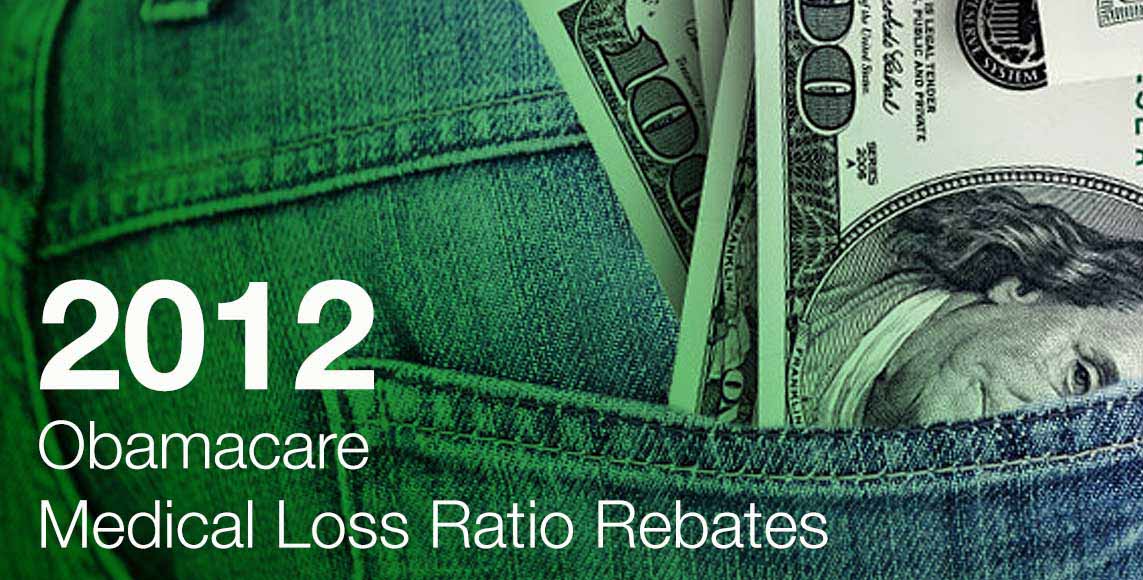
The Affordable Care Act’s requirement that health insurance companies spend 80 percent of your premium dollars on actual health care – rather than marketing, administrative and CEO salaries – returned $1,101,372,250 to 12.8 million American consumers in its first year.
The medical loss ratio – also known as the 80/20 rule – means that insurers for the first time have to disclose where they’re spending plan holder premium dollars. If they spend less than 80 percent (less than 85 percent for large group plans) on providing medical care, they must rebate the excess dollars back to consumers each year.
The average American household received $151 in the first year, with the highest rebates in Vermont ($807), Mississippi ($651), Alaska ($622), Alabama ($518), Maine ($463), Illinois ($380, West Virginia ($374) and Wyoming ($350). See the statistics for your state below.
The medical loss ratio has returned billions in health insurance premium rebates to consumers since 2012.
| ACA’s 2012 medical loss ratio rebates | |||
|---|---|---|---|
| State | Total Rebates | Consumers Benefiting | Average per Family |
| Alaska | $1,280,908 | 2,712 | $622 |
| Alabama | $4,220,331 | 13,556 | $518 |
| Arkansas | $7,787,177 | 115,461 | $114 |
| Arizona | $27,868,667 | 413,912 | $118 |
| California | $73,905,280 | 1,877,186 | $65 |
| Colorado | $27,452,769 | 208,197 | $227 |
| Connecticut | $12,949,130 | 137,452 | $168 |
| District of Columbia | $47,189,436 | 592,234 | $157 |
| Delaware | $1,846,989 | 5,639 | $351 |
| Florida | $123,624,635 | 1,251,397 | $168 |
| Georgia | $19,764,771 | 243,813 | $134 |
| Hawaii | $195,053 | 26,900 | $15 |
| Iowa | $1,469,276 | 28,042 | $100 |
| Idaho | $1,124,918 | 32,576 | $70 |
| Illinois | $61,802,411 | 299,544 | $380 |
| Indiana | $14,249,673 | 283,432 | $99 |
| Kansas | $4,139,506 | 67,512 | $91 |
| Kentucky | $15,326,103 | 249,275 | $114 |
| Louisiana | $4,111,975 | 75,493 | $94 |
| Massachusetts | $11,886,643 | 163,949 | $140 |
| Maryland | $27,882,606 | 141,129 | $340 |
| Maine | $2,579,922 | 10,589 | $463 |
| Michigan | $13,908,262 | 113,995 | $214 |
| Minnesota | $8,956,885 | 123,171 | $160 |
| Missouri | $60,664,564 | 587,654 | $173 |
| Mississippi | $10,122,532 | 51,744 | $329 |
| Montana | $2,607,244 | 25,353 | $194 |
| North Carolina | $18,678,898 | 216,649 | $158 |
| North Dakota | $10,160 | 4,229 | $5 |
| Nebraska | $4,832,049 | 46,444 | $215 |
| New Hampshire | $77,507 | 16,023 | $9 |
| New Jersey | $7,670,066 | 44,998 | $300 |
| New Mexico | $0 | 0 | |
| Nevada | $4,548,500 | 46,590 | $180 |
| New York | $86,526,642 | 1,001,476 | $138 |
| Ohio | $11,331,726 | 143,327 | $139 |
| Oklahoma | $20,296,875 | 263,404 | $126 |
| Oregon | $4,654,772 | 23,394 | $368 |
| Pennsylvania | $51,588,303 | 575,551 | $165 |
| Rhode Island | $0 | 0 | |
| South Carolina | $19,630,152 | 251,632 | $131 |
| South Dakota | $47,948 | 1,370 | $68 |
| Tennessee | $28,810,557 | 240,298 | $201 |
| Texas | $166,975,840 | 1,516,721 | $187 |
| Utah | $3,696,778 | 109,893 | $85 |
| Virginia | $43,127,639 | 686,738 | $115 |
| Vermont | $2,346,018 | 4,636 | $807 |
| Washington | $594,031 | 7,681 | $185 |
| Wisconsin | $10,369,793 | 282,812 | $76 |
| West Virginia | $2,703,790 | 16,434 | $374 |
| Wyoming | $1,112,043 | 6,290 | $350 |
| Guam | $15,394,953 | 46,390 | $852 |
| Northern Mariana Islands | $291,586 | 1,022 | $782 |
| Puerto Rico | $5,508,831 | 58,648 | $225 |
| Virgin Islands | $1,629,124 | 5,698 | $462 |

Get your free quote now through licensed agency partners!







